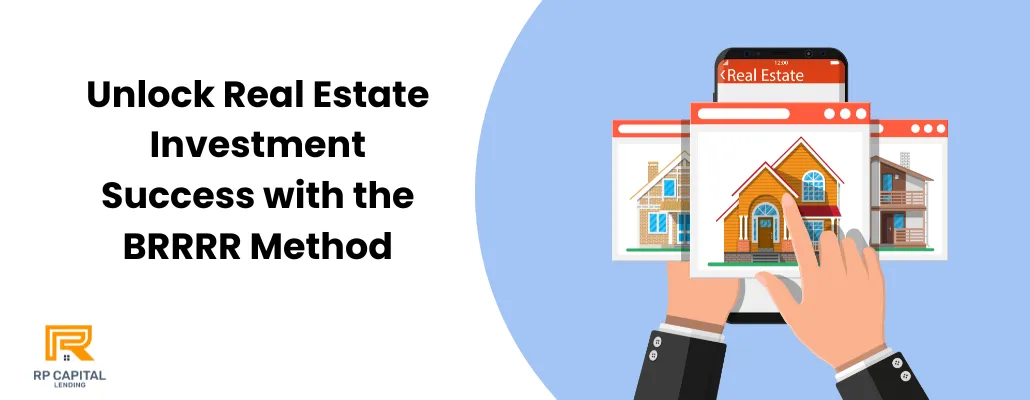Blog

What is BRRRR Method? ( Meaning, Steps, Pros and Cons )
In today’s unpredictable housing market, investors are increasingly shifting from traditional house flipping to a more scalable and sustainable strategy: the BRRRR method. Short for Buy, Rehab, Rent, Refinance, Repeat, this approach allows real estate investors to grow their portfolios with minimal upfront capital and the potential for ongoing cash flow.
What Is the BRRRR Method?
The BRRRR strategy revolves around acquiring undervalued properties, adding value through strategic renovations, generating rental income, refinancing to free up capital, and repeating the process to scale quickly. It’s become especially popular during uncertain market conditions as it offers both short-term gains and long-term wealth-building potential.
How the BRRRR Method Works?
Here’s a detailed breakdown of how the BRRRR method works, complete with pro tips and bonuses to help you get the most out of each step.

1. Buy – Find the Hidden Gem
This first step is all about buying a distressed or undervalued property that you can improve. Think of properties that may look rough now but have great potential with a little TLC. You’re not looking for a dream home—you’re hunting for opportunity.
Look for:
Properties in up-and-coming neighborhoods
Foreclosures or estate sales
Homes with cosmetic issues (paint, flooring, outdated interiors)
Use the 70% Rule:
Never pay more than 70% of the property’s projected after-repair value (ARV), minus estimated repair costs.
Pro Tip:
Run the numbers before you make an offer. Factor in taxes, closing costs, and even buffer for surprise repairs.
🎁 Bonus:
Use tools like PropStream or Zillow to estimate ARV and local comps—these can save you hours of guesswork.
2. Rehab – Add Real Value
Now it’s time to roll up your sleeves (or hire contractors) and start improving the property. Renovations should focus on increasing value and rental appeal—not just making it pretty.
Smart renovations include:
Kitchen and bathroom upgrades
Replacing flooring and old windows
Improving insulation and energy efficiency
Fixing major systems (HVAC, roof, plumbing)
Balance is key: Don’t over-renovate! Spending too much can kill your ROI.
Pro Tip:
Create a rehab budget before closing, and get multiple quotes. Always add 10–15% as a buffer for unexpected costs.
🎁 Bonus:
Aesthetic upgrades like paint, lighting, and modern hardware offer a high-impact look with low cost.
3. Rent – Lock in Steady Cash Flow
After rehab, you’re ready to find quality tenants and turn the property into a cash-producing asset.
Focus on:
Pricing rent based on market research
Marketing the property with good photos and listings
Screening tenants (credit, background, rental history)
Your goal here is to find reliable tenants who will take care of the property and pay on time.
Pro Tip:
Use online platforms like Avail, Zillow Rentals, or RentRedi to simplify screening, leasing, and rent collection.
🎁 Bonus:
Offer small perks (like including water or lawn care) to attract long-term tenants and reduce turnover.
4. Refinance – Unlock Your Investment
Once your rental property is performing and has appreciated in value, it’s time to refinance. This usually means a cash-out refinance, where you replace your original loan with a new one based on the property’s new value—and pocket the difference in cash.
That cash becomes your capital for the next BRRRR deal.
✅ Make sure you:
Have solid documentation of the rehab and rental history
Choose a lender experienced with investment properties
Pro Tip:
Lenders often require a 6-month "seasoning" period before you can refinance—plan for that wait.
🎁 Bonus:
A good refinance also lowers your interest rate or switches you from a high-cost hard money loan to a more affordable long-term mortgage.
5. Repeat – Build Long-Term Wealth
Now that you’ve refinanced and pulled your capital out, you’re ready to do it again. Each cycle increases your property count, cash flow, and equity—all while reusing the same investment capital.
This is how real estate empires are built.
Pro Tip:
Systematize your process. Build a team (realtor, contractor, property manager, lender) so each deal gets easier.
🎁 Bonus:
Keep track of each deal’s numbers in a simple spreadsheet or tool like Stessa—this helps with scaling and taxes.
BRRRR vs. House Flipping: Which Real Estate Strategy Fits You Best?
Both BRRRR and house flipping involve buying and renovating properties, but the way you profit from each method is quite different—and choosing the right one depends on your goals, risk tolerance, and how involved you want to be over time.
House Flipping: Fast Profits, Short-Term Strategy
What it is: Buy low, renovate quickly, and sell high.
Main goal: Capitalize on a one-time profit.
Speed: Quick turnaround—typically a few months.
Cash flow: No monthly income; your profit comes from the sale.
Risk factor: Higher risk due to market fluctuations and tight timelines.
Involvement: Very hands-on and time-sensitive.
💡 Pro Tip: To succeed in flipping, you’ll need sharp market timing and a reliable contractor. Even small renovation delays or cost overruns can cut deep into your profits.
🎁 Bonus: If you're good at design and project management, flipping lets you flex those skills and see immediate results.
BRRRR Method: Long-Term Wealth, Steady Income
What it is: Buy a fixer-upper, renovate it, rent it out, refinance to pull equity, and repeat the process.
Main goal: Build long-term wealth and passive income.
Speed: Slower growth, but it compounds over time.
Cash flow: Generates monthly income from tenants.
Risk factor: Lower short-term risk, but needs patience and strong management.
Involvement: Front-loaded work, then can become more passive.
💡 Pro Tip: Focus on markets with strong rental demand and value appreciation potential for the best BRRRR results.
🎁 Bonus: Unlike flipping, BRRRR builds equity and cash flow, helping you grow a portfolio without constantly starting from scratch.
Pros of the BRRRR Method
Lower capital requirements: You recycle funds instead of raising new capital for every deal.
Scalability: A repeatable system that grows your portfolio quickly.
Ongoing cash flow: Renting generates steady income, unlike flipping.
Higher ROI over time: Combining rental income and appreciation builds lasting wealth.
Operational efficiency: Once streamlined, BRRRR can be systemized and partially automated.
Challenges and Considerations
Financing hurdles: Loans can be expensive, and interest rates impact profitability.
Renovation risks: Underestimating rehab costs or overestimating future value can hurt short-term equity.
Tenant issues: Finding and managing renters takes effort and time.
Market saturation: As BRRRR grows in popularity, finding great deals requires creativity.
Maintenance responsibilities: You’re still on the hook for ongoing property repairs.
Is BRRRR Right for You?
The BRRRR method isn’t a get-rich-quick strategy—it’s a long-term wealth-building approach that requires patience, planning, and persistence. It’s best suited for investors who:

Think long-term: You’re not in it for quick flips or instant returns. You’re building sustainable income and growing equity over time.
Have (or want to build) systems: You’re willing to manage multiple moving parts—renovations, tenants, refinancing—and possibly build a team to help with scale.
Reinvest rather than splurge: When you pull cash out during refinancing, you’re not spending it on vacations—you’re rolling it into your next property.
Can handle property management (or outsource it): Being a landlord means dealing with repairs, tenant issues, and maintenance—unless you hire a property manager.
Want steady, predictable income: If you prefer consistent monthly rental income over risky flips, BRRRR is a great fit.
💡 Pro Tip: Start small. Your first BRRRR deal will teach you a lot, and even if you don’t get it perfect, the lessons compound just like the portfolio does.
🎁 Bonus: You can use creative financing (like hard money loans or partnerships) to get started with minimal capital.
Final Thought: Building Wealth One Property at a Time
The BRRRR method isn’t just a clever acronym—it’s a proven real estate investing framework that can take a single property and turn it into a launchpad for long-term success.
By combining renovation strategy, rental income, and strategic refinancing, you’re not just making money—you’re compounding your results. Each property builds more income, more equity, and more momentum.
If you’re ready to commit, stay consistent, and play the long game, BRRRR could be your key to financial freedom through real estate.
FAQs About the BRRRR Method
Q1: How much capital do I need to start with the BRRRR method?
It varies based on location and property type, but ideally, you should have enough for a down payment, renovation costs, and any unexpected expenses.
Q2: What risks are involved in the BRRRR method?
Key risks include underestimating repair costs, overestimating rental income, or facing challenges in refinancing.
Q3: How long does it typically take to go through one BRRRR cycle?
The timeline can range from several months to a year, depending on the extent of renovations and the refinancing process.
Q4: Can I use the BRRRR method in any real estate market?
While it's versatile, success often depends on choosing the right market. Areas with strong rental demand and potential for property appreciation are ideal.
Q5: Are there any specific types of properties best suited for the BRRRR method?
Properties that are structurally sound but need cosmetic updates are ideal, as they typically require less capital and time for renovations.
RP Capital Lending is a d.b.a of RP Capital Partners Inc (NMLS # 2469193) | Privacy Policy
Copyright © 2022. All Rights Reserved.
Disclaimer: Loans only apply to non-owner occupied properties. Rates, terms and conditions offered only to qualified borrowers, may vary upon loan product, deal structure, other applicable considerations, and are subject to change at any time without notice.

